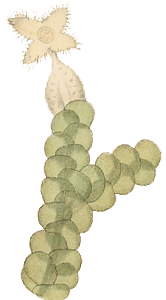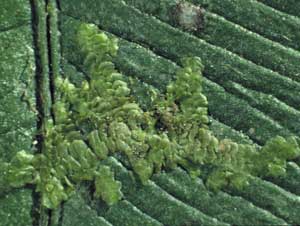
Ecology
Epiphyllous bryophytes
Epiphyllous or foliicolous bryophytes are those that grow on the leaves of vascular plants. Such epiphylls are widespread, and often quite common, in the tropical areas where there are long periods of high humidity. Two examples are the leafy liverworts Lopholejeunea muelleriana var. australis ![]() and Cololejeunea lanciloba
and Cololejeunea lanciloba ![]() , both pictured growing on the leaves of vascular rainforest plants on Christmas Island in the Indian Ocean. Many epiphyllous species are strictly epiphyllous but some may also be found on other plant parts (twigs, branches, trunks) or even non-plant substrates such as rocks. Liverworts are by far the commonest of the epiphyllous bryophytes. Apart from bryophytes you can also find algae, cyanobacteria, lichens and fungi growing on vascular plant leaves. The living space on the leaf surface is referred to as the phyllosphere and from what's already been said about the variety of epiphylls to be found on leaf surfaces, it's clear that the phyllosphere can be a complex micro-habitat. There is still much that is unknown about the roles and interactions of epiphyllous bryophytes.
, both pictured growing on the leaves of vascular rainforest plants on Christmas Island in the Indian Ocean. Many epiphyllous species are strictly epiphyllous but some may also be found on other plant parts (twigs, branches, trunks) or even non-plant substrates such as rocks. Liverworts are by far the commonest of the epiphyllous bryophytes. Apart from bryophytes you can also find algae, cyanobacteria, lichens and fungi growing on vascular plant leaves. The living space on the leaf surface is referred to as the phyllosphere and from what's already been said about the variety of epiphylls to be found on leaf surfaces, it's clear that the phyllosphere can be a complex micro-habitat. There is still much that is unknown about the roles and interactions of epiphyllous bryophytes.
At first it would seem that anything growing on a plant leaf must be detrimental to that plant and the following are some of the theoretical arguments that have been advanced to support that hypothesis. If part of a leaf is covered the total leaf photosynthesis is reduced so that there is less food production. The rhizoids that anchor an epiphyllous bryophyte to its host leaf, may penetrate the leaf and so provide potential entry points for pathogenic organisms. Moreover, moisture held by the bryophytes creates a more humid microhabitat on the leaf surface, potentially ideal for various pathogenic micro-organisms. As plausible as such arguments may sound they must still be tested, rather than automatically accepted, and the reality is not necessarily what the arguments suggest. A case in point is the argument about epiphyllous cover reducing leaf photosynthesis. Botanists studying the effects of the epiphyllous leafy liverwort Radula flaccida found the liverwort intercepted up to about 2% of the incident light. It's worth noting that even in the case of epiphyllous lichens, with greater light interception, there need not be much effect on plant photosynthesis. This was the subject of a study in Queensland's Mossman Gorge National Park that looked closely at the effects of epiphyllous lichens on leaves of Calamus australis, a palm, and Lindsayomyrtus racemoides, a plant in the family Myrtaceae. The latter species was formerly known by the name Eugenia racemoides. Eleven lichen species were involved and the amount of light transmitted through the lichens to the underlying leaf varied from about 30 to 70 percent of the incident light, depending on the lichen species. The researchers found that the host leaves compensated for the epiphyllous lichens and that total photosynthesis was not reduced. In both host plants the chlorophyll content in those parts of the leaves colonized by lichens was significantly higher than in uncolonized leaf areas. Of course, these results need not hold for other species of lichens and perhaps not for other vascular host species. However the lichen study confirms that the simplistic theoretical conclusion about photosynthesis, given early in this paragraph, cannot hold in general![]() .
.
The leafy liverwort Radula flaccida is widespread in tropical Africa and South America and grows on a variety of vascular plant leaves. An investigation into the behaviour of this liverwort has shown that it can be described as semi-parasitic on its host. The liverwort certainly contains chlorophyll and so gathers its own carbon via photosynthesis. The rhizoids penetrate the cuticle of the host leaf, come into contact with living cells inside the leaf and water and phosphorous (but no carbon) pass from the host leaf to the liverwort. Rhizoid penetration leads to the death of non-chlorophyllous epidermal cells in the host leaf and such damage might be expected to open the leaf to fungal attack. However no great degree of fungal infection was found except in leaves already near the end of their normal lifespan. The study showed that the mineral and water transfer to the Radula was very unlikely to have a detrimental effect on the host plant except in extreme conditions![]() .
.
Thus far you could be excused for concluding that, while host leaves can at best tolerate epiphyllous associates, there's not really anything in it for the hosts.
In another study undertaken in Costa Rica two researchers carefully removed liverworts and lichens from randomly selected leaves of grapefruit (Citrus paradisi) and an understorey cyclanth (Cyclanthus bipartitus). They found that the denuded leaves suffered 2 to 3 times more damage by leafcutter ants (“one of the most destructive herbivores in neotropical rainforests”) than was the case with the covered leaves. Presumably the chemicals produced by the liverworts or lichens are harmful either directly to the ants or to the ants’ fungus gardens. Liverworts and lichens both produce a considerable array of chemical compounds but the study did not try to differentiate lichen from liverwort effects![]() .
.
Cyanobacteria (sometimes still referred to as blue-green algae) make use of the micro-habitats created by epiphylls, particularly the micro-habitats created by epiphyllous bryophytes. Nitrogen is essential for life and gaseous nitrogen is abundant in the atmosphere, but in that form it is unusable by plant life. Cyanobacteria can fix atmospheric nitrogen, which is to say convert it into a usable form. Nitrogen fixed by epiphyllous cyanobacteria can be absorbed by the vascular leaf or taken up by the other epiphylls. This website gives some more information about this topic. The contribution made to vascular plants by epiphyllous nitrogen fixers is variable. One study found that from 10% to 25% of the nitrogen present within a host leaf could be derived from epiphyllous nitrogen fixers – but there have also been reports of lower contributions. It has also been shown that nitrogen may pass between epiphyllous liverworts and host vascular leaves, the direction of movement depending on both the species involved as well as various other factors. For example, nutrients may leak out of damaged host leaves and thereby become available to the inhabitants of the phyllosphere. On the other hand, it is well-known that re-hydrating bryophytes leak nutrients in the early stages of re-hydration from the dry state. Once re-hydrated the bryophytes could re-absorb the lost nutrients but it's possible that in the intervening time those nutrients may have been absorbed by the host leaf. The studies to date support the idea that epiphyllic nitrogen fixation can contribute significantly to the nitrogen supply in tropical forests and that the micro-habitats created by epiphyllous bryophytes are important in this![]() .
.
There is evidence that bryophytes have been inhabiting leaves for a long time. There are relevant fossils from the Kiandra area of New South Wales dating from the Lower Miocene (about 16-23 million years ago) and earlier fossils from Germany, dating to the Lower Eocene (about 48 to 55 million years ago). All these are of mosses that resemble the present-day genus Ephemeropsis. Several of the Kiandra specimens had been growing on leaves of plants seemingly in the family Myrtaceae and one on a leaf of a plant in the family Lauraceae![]() .
.
This page started with the observation that epiphyllous liverworts are very common in the tropics, but such bryophytes, though more common there, are not confined to the tropics. They have been found also in sub-tropical to temperate regions in various parts of the world. To finish the page, here's a photo of an epiphyllous leafy liverwort, Radula compacta, growing on a frond of a fern in the genus Blechnum in a sheltered area of the Blue Mountains, west of Sydney, in temperate Australia.
![An Australian Government Initiative [logo]](/images/austgovt_brown_90px.gif)


